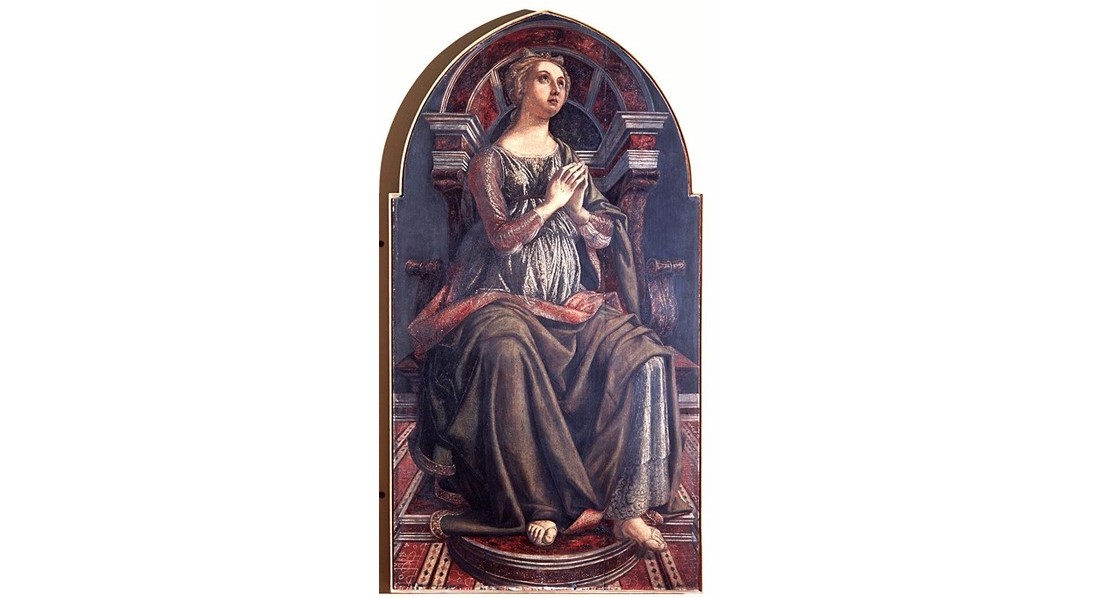+39 0669887260 | info@wucwo.org | Contact us
Art for meditation - February 2024

Piero del Pollaiolo (Florence 1441 - Rome 1496), La Speranza, 1469-72, tempera grassa on panel, 168 x 90.5 cm, Florence, Uffizi Museum
The virtues: Hope
We continue to examine the pictorial cycle dedicated to the Virtues that was commissioned to Piero del Pollaiolo in 1469 and destined for the Audience Room in the Tribunale di Mercanzia in Piazza della Signoria in Florence.
Before examining the second painting in the cycle, let us recall what we mean when we speak of the "theological" virtues (faith, which we wrote about last month, hope and then charity). In the Catechism of the Catholic Church we read: “the theological virtues relate directly to God. They dispose Christians to live in a relationship with the Holy Trinity. They have the One and Triune God for their origin, motive, and object. The theological virtues are the foundation of Christian moral activity; they animate it and give it its special character. They inform and give life to all the moral virtues. They are infused by God into the souls of the faithful to make them capable of acting as his children and of meriting eternal life. They are the pledge of the presence and action of the Holy Spirit in the faculties of the human being. There are three theological virtues: faith, hope, and charity”. (Nº 1812-1813).
Hope is depicted by Pollaiolo once again as a young woman. The thing that we immediately notice is that she has no object in her hand (the objects that characterize people or pictorial subjects are called "attributes"), but central becomes the gesture she makes with her hands: they are joined, in the attitude of prayer. And that the woman is praying is confirmed by the enraptured look that turns upwards. She seems almost in ecstasy, she seems to entrust herself entirely to God, to contemplate his glory.
If we read the definition of Hope that the same Catechism gives us at no. 1817 ( “Hope is the theological virtue by which we desire the kingdom of heaven and eternal life as our happiness, placing our trust in Christ's promises and relying not on our own strength, but on the help of the grace of the Holy Spirit. ") we realize how Pollaiolo has grasped, many centuries before, the essential characteristics of this virtue. The woman does not need anything other than the green of her dress (even today we match the green color to the virtue of hope!) because the rest comes to her directly from God to whom she is striving with all of herself.
Hope too is seated on a throne because it is worthy of being glorified and honored, as it sustains in moments of abandonment, overcomes all discouragement, opens the heart to the expectation of the Lord’s coming.
My God, rescue me from the hand of the wicked, from the clutches of the evil and violent.
You are my hope, Lord; my trust, GOD, from my youth. On you I have depended since birth; from my mother’s womb you are my strength; my hope in you never wavers. (Psalm 71, 4-6)
For in hope we were saved. Now hope that sees for itself is not hope. For who hopes for what one sees? But if we hope for what we do not see, we wait with endurance. (Romans 8, 24-25)
So when God wanted to give the heirs of his promise an even clearer demonstration of the immutability of his purpose, he intervened with an oath, so that by two immutable things, in which it was impossible for God to lie, we who have taken refuge might be strongly encouraged to hold fast to the hope that lies before us. This we have as an anchor of the soul, sure and firm, which reaches into the interior behind the veil, where Jesus has entered on our behalf as forerunner, becoming high priest forever according to the order of Melchizedek. (Hebrews 6, 17-20)
(Contribution by Vito Pongolini)